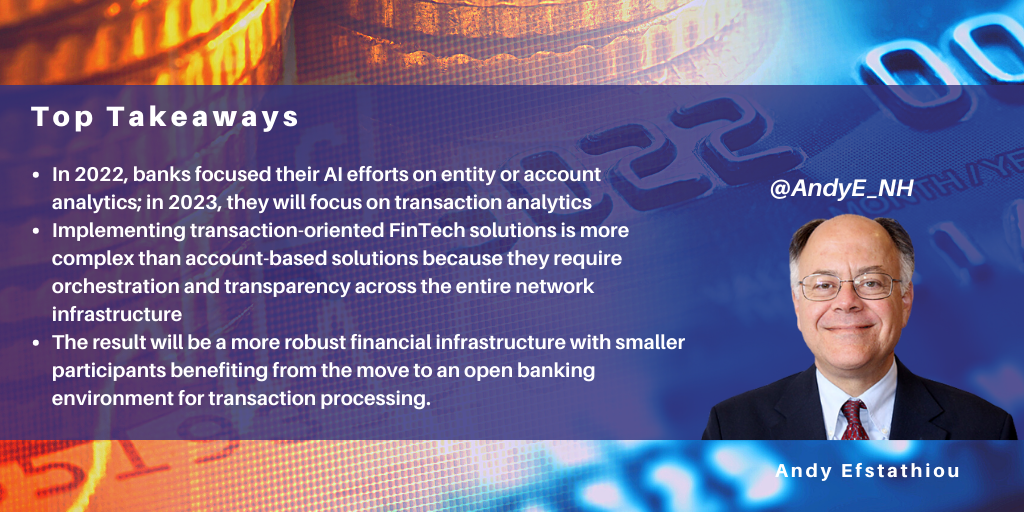posted on Dec 09, 2022 by Andy Efstathiou

2022 has been a very strong year for IT services firms delivering cloud, digital, and AI services to the financial services industry. 2023 looks to be a very different year for these vendors as they are finding it difficult to hire skilled resources, find clients able to fund new large projects, and partner in strategic growth areas. Successful BFS technology consultants will need to focus limited resources in a few key growth areas to have a successful business in 2023. One strategic area for growth will be implementing transaction processing AI and data management tools.
To date, banks have focused their AI efforts on entity or account analytics. Typically, these tools provide customer service (e.g., customer onboarding and next-best recommendations) and compliance support (e.g., AML/KYC). We believe in 2023 banks will turn their compliance and customer analytics focus from entity analytics to transaction analytics. Financial institutions are driven by evolving regulations, which today are emerging faster from Europe than other geographies. Europe has several new regulations which are driving a change in focus to transaction monitoring. These include:
- The Digital Operations Resiliency Act (DORA): DORA seeks to mitigate the risk of cyber attacks on financial operations. Previous regulations took a balance sheet-based approach to risk mitigation by requiring capital buffers to address operational risk. DORA takes an operational approach to mitigating risk by requiring technology (i.e., cloud, supply chains, and IT outsourcers) to operate with transparency, rigor, and resiliency. The act was published on 11/17/2022, will come into force by Q1 2023, and financial institutions will be required to have implemented it by Q4 2024.
- A pilot regimen for market infrastructure in DLT: Passed June 2, 2022 by the EU, this regulation covers trading of currencies/securities using blockchain technology in multilateral trading facilities and settlement systems
- Regulations governing real-time payments/transactions: regulations include PSD2 and various securities settlement regulations, which have been shortening the settlement windows for various securities transactions towards an ultimate goal of instant transactions. Platforms need to move from batch processing to real-time processing with improved security and risk management to mitigate fraud and credit risk. An example of real-time payments implementation is the launch scheduled for summer 2023 of FedNow, the Federal Reserve bank’s instant payment service.
These regulations will drive securities exchanges, payments networks, banks, and capital markets firms to deploy cloud orchestration and AI FinTech tools to improve security and reduce operational risk. Already financial institutions are starting projects to address these challenges. Examples include:
- Goldman Sachs Transaction Bank (GS TxB): On Sept. 15, 2022 GS TxB announced a partnership with Stripe to provide corporate treasury services with embedded finance (the ability to make payments as part of the treasury application). This service requires APIs and AI to manage and deliver transaction flows safely and securely.
- State Street Bank launching a peer-to-peer repo program for the buy side to reduce the cost of collateral management, which is a critical trading cost. This facilitates bilateral trading by counterparties with varying credit and capital strength.
Implementing these transaction-oriented FinTech solutions is more complex than account-based solutions because transaction-oriented solutions require orchestration and transparency across the entire network infrastructure. These projects will be driven by the market exchanges and tier one institutions, but will require cooperation from all market participants.
The result will be a more robust financial infrastructure with smaller participants benefiting from the move to an open banking environment for transaction processing. The promise of safe digital payments in a decentralized environment will not be achievable without these investments in securing the industry infrastructure. The industry and regulators are committed to delivering on the promise, so the implementation work will start in 2023.

